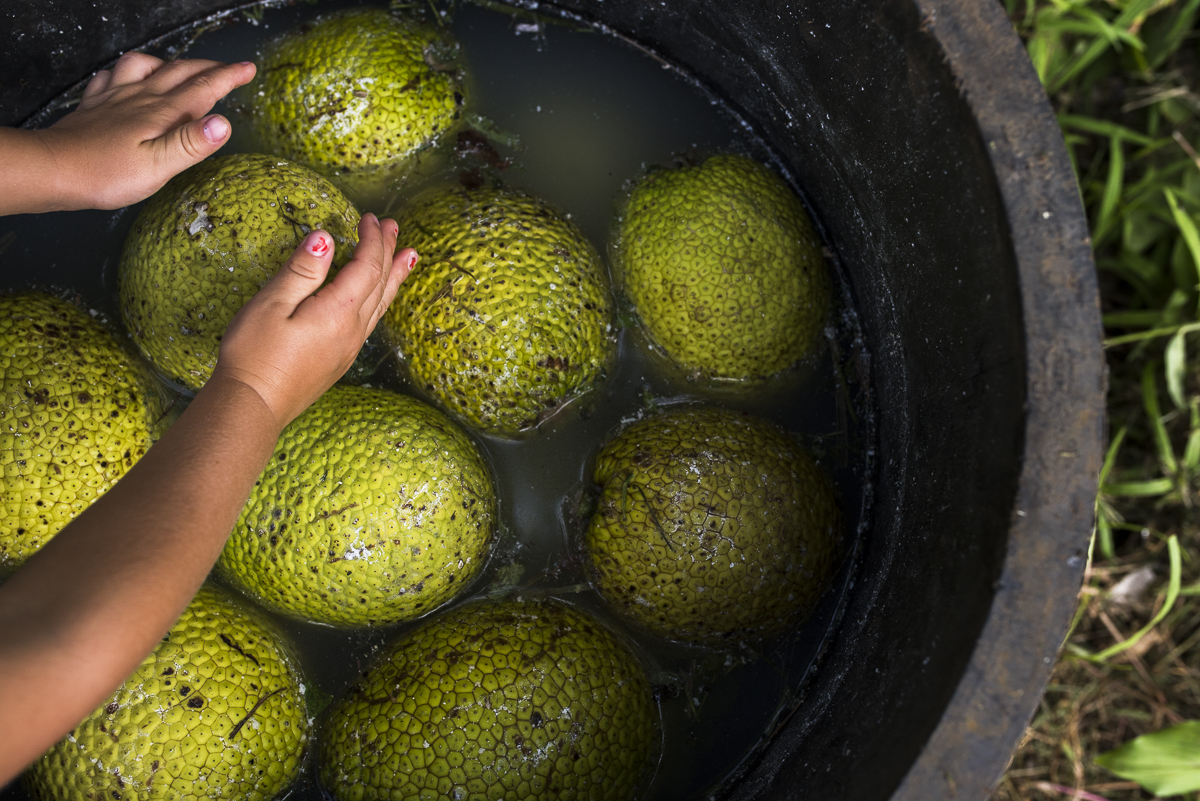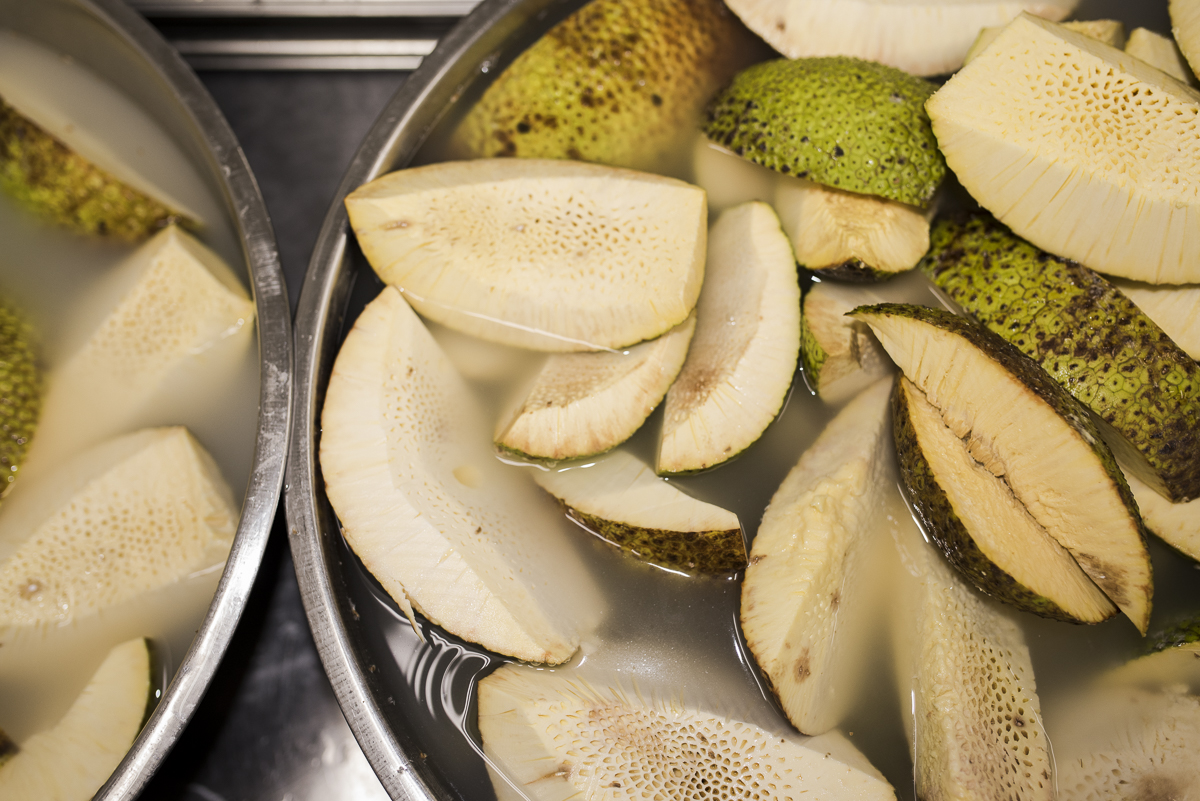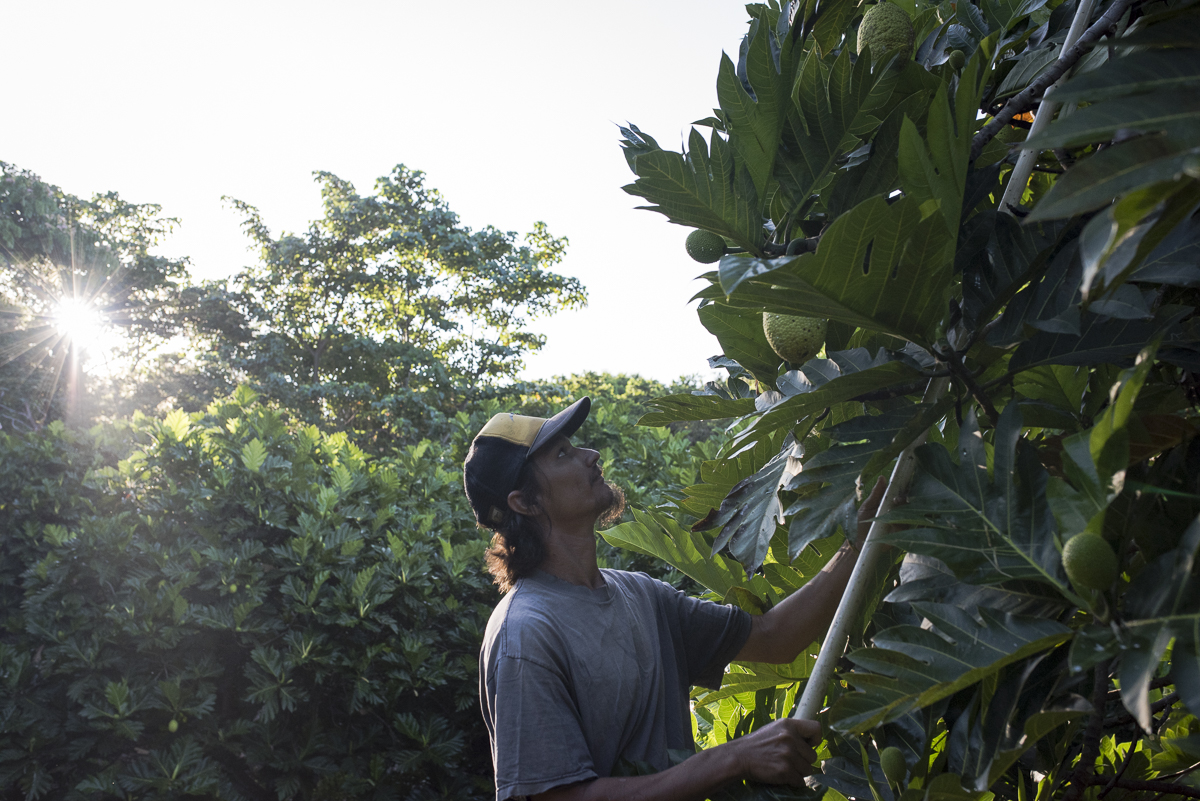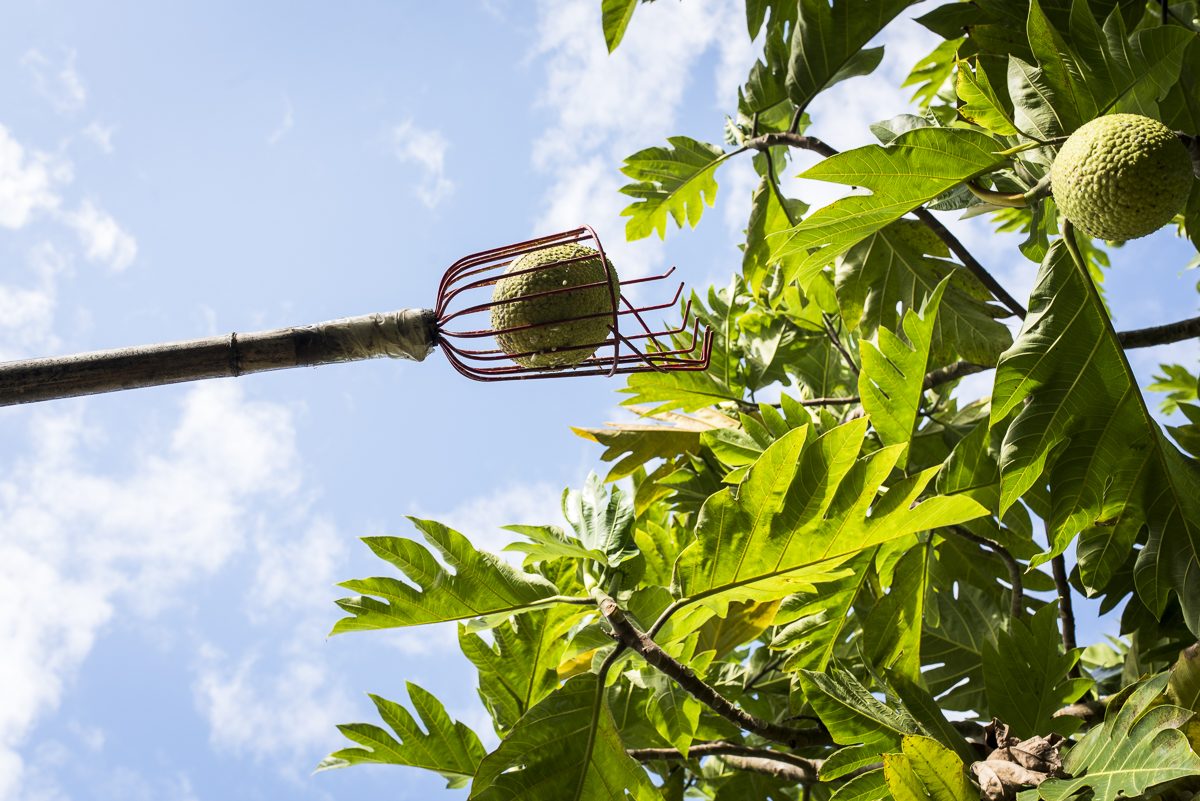Mending Hawaii’s Lack of Food Security Through Breadfruit
Hawai’i ‘Ulu Cooperative is investing in the nutritious indigenous crop as one way to address the islands’ broken food system.
Mending Hawaii’s Lack of Food Security Through Breadfruit
Hawai’i ‘Ulu Cooperative is investing in the nutritious indigenous crop as one way to address the islands’ broken food system.

Breadfruit, or ‘ulu in native Hawaiian, is a complete protein and a good source of complex carbohydrates.by Ronit Fahl.
With about 3,850 kilometers to the nearest continent, Hawaii is one of the most isolated island chains in the world. When it comes to feeding its 1.41 million residents, the state spends up to $3 billion a year to import as much as 90 percent of its food. Studies show that the issue isn’t a lack of agricultural land, but rather the fact that the islands grow way more exported commodities, such as coffee, and not enough food to feed the local population. As a result, essential groceries are costly—we’re talking $9 for a loaf of bread—contributing to one in nine people in Hawaii experiencing food insecurity.
Food insecurity was only exacerbated by the pandemic. And with climate change, the islands are facing greater threats from rising temperatures and rising oceans. Something about Hawaii’s food system has to change.
Hawai‘i ‘Ulu Cooperative and other advocates believe the solution can be found in a starchy crop called breadfruit, or ‘ulu in native Hawaiian. While ‘ulu has indigenous roots in Hawaii, the organization says it’s under-utilized, and is pushing to make the fruit a staple in local diets. To do so, it first needs to decolonize Hawaii’s food system to benefit farmers and the greater public alike.
For those unfamiliar, ‘ulu is what Dana Shapiro, a farmer and general manager of Hawaiʻi ‘Ulu Cooperative, describes as “a big tropical tree potato.” Grown on trees, ‘ulu is a round or oval fruit with skin the shade of a tennis ball. The plant thrives in tropical climates, where ‘ulu trees are not only an abundant and perennial producer but resilient to temperature and precipitation swings.
According to the Breadfruit Institute at the National Tropical Botanical Garden, ‘ulu is a complete protein and a good source of complex carbohydrates with other nutrients, such as potassium, Vitamin C and calcium. ‘Ulu can be cooked any way a potato can—think chips, fries or mash. It can also be dried and ground into a gluten-free flour. In Hawaii, it’s commonly pounded into a poi-like paste. Once ripe, its flesh softens like a sweet custard and can be eaten raw for dessert.

For at least 800 years, ‘ulu has been woven into the cultural fabric of Hawaii. For instance, there’s the moʻolelo (story, legend) of Kū, the Hawaiian god of war and prosperity, who turned himself into an ‘ulu tree to save his family during a grave famine. Ancient Hawaiians had ‘ulu groves in South Kona on Hawaii Island and ate the fruit with kalo (taro) and mai’a (banana or plantains) as staple carbs in their diet.
With European contact came diseases that wiped out Hawaii’s Indigenous population and its culture. This included their labor-intensive agricultural systems. The traditional Hawaiian food system collapsed largely because of this, Shapiro says. As westernization intensified, imported staples like wheat and rice became the dominant starches and ‘ulu at the market became rare. In the 1970s, activists and advocates spurred a cultural renaissance, with the revival of traditional crops being a central component.
Shapiro, an expert in cooperatives who is originally from Israel, saw the next step to be commercialization. In 2016, she and her husband Noa Lincoln, a University of Hawaii professor who researches indigenous crops in the College of Tropical Agriculture and Human Resources (CTAHR) department, founded the Hawaiʻi ‘Ulu Cooperative with eight other small farms. Together they are trying to collaborate and create a market that would get ‘ulu on more plates. “By building it as a farmer co-op, we’re ensuring that the farmers are forever going to be in control and I believe that’s important in developing the industry,” Shapiro says.

Now into their fifth year, the cooperative has grown rapidly to encompass 110 farmers. Pre-pandemic, the co-op sold to hotels like the Four Seasons Resort Hualalai on Hawaii Island and 256 public schools statewide. At its factory on Hawaii Island, the cooperative creates and sells products like ‘ulu flour, hummus and packaged frozen ‘ulu chunks that just need to be warmed up.
Andrew Trump (no relation to the former president) is a second-generation farmer for Island Harvest Hawaiʻi, an organic farm specializing in macadamia nuts located in Kohala on Hawaii Island. “We want to contribute to the local economy as a small business and small farm, plus be a part of revitalizing a food system in a way that acknowledges the past and pays homage to what Native Hawaiians have been doing for centuries,” Trump says. The farm now has a few hundred ‘ulu trees, some of which have died from wild pig debarking, but the trees that remain are just beginning to bear their first fruits.
Trump adds that the cooperative is a pilot program that could help change Hawaii’s food system. “If more organizations, more farmers and more people succeed and show that we can do this, it just adds to the momentum, eventually creating a food system that’s not just about consuming local foods, but also about sustaining local farmers, protecting local land from development and acknowledging the value of indigenous practices,” he says.

Farming ‘ulu in groves like ancient Hawaiians did is known as agroforestry. This has a wide variety of benefits for the planet such as carbon sequestration, improved soil, better watershed conditions and water use efficiency.
There’s still a long road ahead for Hawai‘i ‘Ulu Cooperative. Although the co-op is close to turning a profit, ‘ulu farming on a scale is still nascent. Grant funding and research haven’t always focused on indigenous crops like ‘ulu, and the farmers partnering with Lincoln at the University of Hawaii are figuring out challenges as they go, like fertilization and diversification.
“A lot of really basic questions have just not been answered,” Lincoln says. “Hundreds of crops in the tropics aren’t well-utilized because it’s the European history of agriculture, globally. I hope Hawaii can serve as an example of what real local food security and resilience looks like and that’s increasingly important for the world.”
Follow us
This work is licensed under a Creative Commons Attribution-NoDerivatives 4.0 International License.
Want to republish a Modern Farmer story?
We are happy for Modern Farmer stories to be shared, and encourage you to republish our articles for your audience. When doing so, we ask that you follow these guidelines:
Please credit us and our writers
For the author byline, please use “Author Name, Modern Farmer.” At the top of our stories, if on the web, please include this text and link: “This story was originally published by Modern Farmer.”
Please make sure to include a link back to either our home page or the article URL.
At the bottom of the story, please include the following text:
“Modern Farmer is a nonprofit initiative dedicated to raising awareness and catalyzing action at the intersection of food, agriculture, and society. Read more at <link>Modern Farmer</link>.”
Use our widget
We’d like to be able to track our stories, so we ask that if you republish our content, you do so using our widget (located on the left hand side of the article). The HTML code has a built-in tracker that tells us the data and domain where the story was published, as well as view counts.
Check the image requirements
It’s your responsibility to confirm you're licensed to republish images in our articles. Some images, such as those from commercial providers, don't allow their images to be republished without permission or payment. Copyright terms are generally listed in the image caption and attribution. You are welcome to omit our images or substitute with your own. Charts and interactive graphics follow the same rules.
Don’t change too much. Or, ask us first.
Articles must be republished in their entirety. It’s okay to change references to time (“today” to “yesterday”) or location (“Iowa City, IA” to “here”). But please keep everything else the same.
If you feel strongly that a more material edit needs to be made, get in touch with us at [email protected]. We’re happy to discuss it with the original author, but we must have prior approval for changes before publication.
Special cases
Extracts. You may run the first few lines or paragraphs of the article and then say: “Read the full article at Modern Farmer” with a link back to the original article.
Quotes. You may quote authors provided you include a link back to the article URL.
Translations. These require writer approval. To inquire about translation of a Modern Farmer article, contact us at [email protected]
Signed consent / copyright release forms. These are not required, provided you are following these guidelines.
Print. Articles can be republished in print under these same rules, with the exception that you do not need to include the links.
Tag us
When sharing the story on social media, please tag us using the following: - Twitter (@ModFarm) - Facebook (@ModernFarmerMedia) - Instagram (@modfarm)
Use our content respectfully
Modern Farmer is a nonprofit and as such we share our content for free and in good faith in order to reach new audiences. Respectfully,
No selling ads against our stories. It’s okay to put our stories on pages with ads.
Don’t republish our material wholesale, or automatically; you need to select stories to be republished individually.
You have no rights to sell, license, syndicate, or otherwise represent yourself as the authorized owner of our material to any third parties. This means that you cannot actively publish or submit our work for syndication to third party platforms or apps like Apple News or Google News. We understand that publishers cannot fully control when certain third parties automatically summarize or crawl content from publishers’ own sites.
Keep in touch
We want to hear from you if you love Modern Farmer content, have a collaboration idea, or anything else to share. As a nonprofit outlet, we work in service of our community and are always open to comments, feedback, and ideas. Contact us at [email protected].by Kathleen Wong, Modern Farmer
December 10, 2021
Modern Farmer Weekly
Solutions Hub
Innovations, ideas and inspiration. Actionable solutions for a resilient food system.
ExploreExplore other topics
Share With Us
We want to hear from Modern Farmer readers who have thoughtful commentary, actionable solutions, or helpful ideas to share.
SubmitNecessary cookies are absolutely essential for the website to function properly. This category only includes cookies that ensures basic functionalities and security features of the website. These cookies do not store any personal information.
Any cookies that may not be particularly necessary for the website to function and are used specifically to collect user personal data via analytics, ads, other embedded contents are termed as non-necessary cookies.
“A lot of really basic questions have just not been answered,” Lincoln says. “Hundreds of crops in the tropics aren’t well-utilized because it’s the European history of agriculture, globally…” Is he referring to plantation farming? Or, large scale monocropping in general? “First evidence of farming in Mideast 23,000 years ago” https://www.sciencedaily.com/releases/2015/07/150722144709.htm